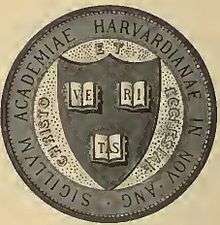Heraldry of Harvard University
Harvard University adopted an official seal soon after it was founded in 1636 and named "Harvard College" in 1638; a variant is still used.

Each school within the university (Harvard College, Harvard Medical School, Harvard Law School, Harvard Graduate School of Arts and Sciences, etc.) has its own distinctive shield as well, as do many other internal administrative units such as the Harvard College residential "Houses" and the Harvard Library. Many extracurricular organizations—such as clubs, societies, and athletic teams—also have their own shield, often based on the coat of arms of Harvard itself.
Harvard University coat of arms


Description
The Harvard University coat of arms, or shield, has a field of the color "Harvard Crimson" and, in the foreground, has three open books with the word VERITAS (Latin for "truth") inscribed across them. This shield provides the basis for the shields of Harvard University's various schools.
History
The Harvard Board of Overseers originally designed the shield during meetings in December 1643 and January 1644. However, the design was forgotten until rediscovered by University President Josiah Quincy and revealed in the bicentennial celebrations of 1836. In 1843, the Harvard Corporation officially adopted it as a seal, and the seal in use today is very similar.[1]
Extension School
The coat of arms for the Harvard Extension School was approved in 1983.[2] At the top of the shield the three books spelling out Veritas (Latin, "truth") represent graduate education; a similar arrangement is seen on the arms of Harvard's law school, medical school, and other graduate schools.[2] Instead of a straight line separating it from the rest of the shield, as is found in the other schools, a line with six arcs pointing up was used instead.[2] A silver chevron was used to represent undergraduate education, a device used in the shield of Harvard College in the 17th to 19th centuries.[2] Two bushels of wheat are included to represent John Lowell's stipulation that courses should not cost more than two bushels of wheat.[2] A golden lamp symbolizes both learning and the fact that some classes are taught at night.[2]
References
- "History | Harvard University". Harvard University. Retrieved 2015-11-24.
- Shinagel, Michael (2010). The Gates Unbarred: A History of University Extension at Harvard, 1910–2009. Harvard University Press. p. 137. ISBN 978-0674051355.
Sources
- Hammond, Mason (July 1981). "A Harvard Armory: Part I". Harvard Library Bulletin. XXIX (3): 261–297.
- Hammond, Mason (October 1981). "A Harvard Armory: Part II". Harvard Library Bulletin. XXIX (4): 361–402.
- Hammond, Mason (Summer 1986). "A Harvard Armory: Part III". Harvard Library Bulletin. XXXIV (3): 251–293.
- Hammond, Mason (Summer 1987). "Official Terms in Latin and English for Harvard College or University". Harvard Library Bulletin. XXXV (3): 294–310.
- Harvard University. Corporation. Seals, 1650-[1926]. UAI 15.1310, Harvard University Archives.
- Morison, Samuel Eliot (September 1933). "Harvard Seals and Arms". Harvard Graduates' Magazine. 42.
- Morison, Samuel Eliot (1936). "Harvard College in the Seventeenth Century. Part I": 11. Cite journal requires
|journal=(help) - Morison, Samuel Eliot (1995). "The Founding of Harvard College": 3, 193, 325, 328–30. Cite journal requires
|journal=(help) - Rosenmeier, Jesper (January 1968). "Veritas: The Sealing of the Promise". Harvard Library Bulletin. XVI (1): 26–37.
- Spindle, Robert B. (May–June 1996). "02138. Arms and the (10,000) men". Harvard Magazine. Vol. 98 no. 5. Letter to the editor.
- Bethell, John T. (March–April 1996). "Variations on a Theme". Harvard Magazine. Vol. 98 no. 4.
- Williams, George Huntston (2014). Divinings: Religion at Harvard: From Its Origins in New England Ecclesiastical History to the 175th Anniversary of The Harvard Divinity School, 1636–1992. Vandenhoeck & Ruprecht. p. 82. ISBN 978-3-525-55056-4.
External links
- Seal of approval, May 14, 2015, Harvard Gazette